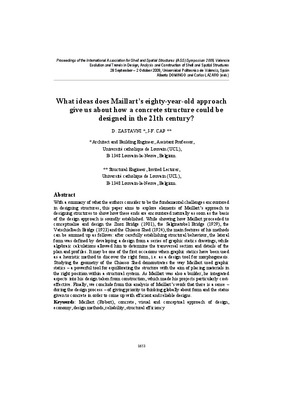JavaScript is disabled for your browser. Some features of this site may not work without it.
Buscar en RiuNet
Listar
Mi cuenta
Estadísticas
Ayuda RiuNet
Admin. UPV
What ideas does Maillart's eigth-year-old approach give us about how a concrete structure could be designed in the 21st century?
Mostrar el registro sencillo del ítem
Ficheros en el ítem
| dc.contributor.author | ZASTAVANI, D.
|
|
| dc.contributor.author | CAP, J. F.
|
|
| dc.contributor.editor | Domingo Cabo, Alberto
|
es_ES |
| dc.contributor.editor | Lázaro Fernández, Carlos Manuel
|
es_ES |
| dc.date.accessioned | 2009-12-23T10:15:35Z | |
| dc.date.available | 2009-12-23T10:15:35Z | |
| dc.date.issued | 2009-12-23T10:15:35Z | |
| dc.identifier.isbn | 978-84-8363-461-5 | |
| dc.identifier.uri | http://hdl.handle.net/10251/6782 | |
| dc.description | p. 1653-1660 | en_EN |
| dc.description.abstract | With a summary of what the authors consider to be the fundamental challenges encountered in designing structures, this paper aims to explore elements of Maillart's approach to designing structures to show how these ends are encountered naturally as soon as the basis of the design approach is soundly established. While showing how Maillart proceeded to conceptualise and design the Zuoz Bridge (1901), the Salginatobel Bridge (1929), the Vatschielbach Bridge (1923) and the Chiasso Shed (1924), the main features of his methods can be summed up as follows: after carefully establishing structural behaviour, the lateral form was defined by developing a design from a series of graphic statics drawings, while algebraic calculations allowed him to determine the transversal section and details of the plan and profiles. It may be one of the first occasions when graphic statics have been used as a heuristic method to discover the right form, i.e. as a design tool for morphogenesis. Studying the geometry of the Chiasso Shed demonstrates the way Maillart used graphic statics -- a powerful tool for equilibrating the structure with the aim of placing materials in the right position within a structural system. As Maillart was also a builder, he integrated aspects into his design taken from construction, which made his projects particularly costeffective. Finally, we conclude from this analysis of Maillart's work that there is a sense -- during the design process -- of giving priority to thinking globally about form and the status given to concrete in order to come up with efficient and reliable designs. | en_EN |
| dc.language | Inglés | en_EN |
| dc.publisher | Editorial Universitat Politècnica de València | es_ES |
| dc.relation.ispartof | Symposium of the International Association for Shell and Spatial Structures (50th. 2009. Valencia). Evolution and Trends in Design, Analysis and Construction of Shell and Spatial Structures : Proceedings | en_EN |
| dc.rights | Reserva de todos los derechos | en_EN |
| dc.subject | Maillart (robert) | en_EN |
| dc.subject | Concrete | en_EN |
| dc.subject | Visual and conceptual approach of design | en_EN |
| dc.subject | Economy | en_EN |
| dc.subject | Design methods | en_EN |
| dc.subject | Reliability | en_EN |
| dc.subject | Structural efficiency | en_EN |
| dc.title | What ideas does Maillart's eigth-year-old approach give us about how a concrete structure could be designed in the 21st century? | en_EN |
| dc.type | Comunicación en congreso | en_EN |
| dc.rights.accessRights | Abierto | es_ES |
| dc.description.bibliographicCitation | Zastavani, D.; Cap, JF. (2009). What ideas does Maillart's eigth-year-old approach give us about how a concrete structure could be designed in the 21st century?. Editorial Universitat Politècnica de València. http://hdl.handle.net/10251/6782 | es_ES |
| dc.relation.conferencename | Symposium of the International Association for Shell and Spatial Structures | es_ES |
| dc.relation.conferencedate | 2009 | es_ES |
| dc.relation.conferenceplace | Valencia | es_ES |






